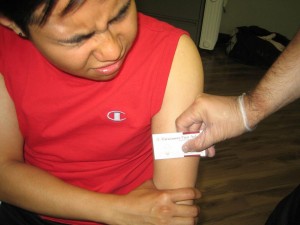Bee poisoning is basically a serious body reaction to the venom from a bee sting. Yellow jackets and wasps also have the same venom and can lead to the similar body reaction. In most cases, bee stings do not cause any serious reaction. Nevertheless, if an individual is allergic or had previous bee stings, they might experience a severe reaction. Always remember that bee poisoning entails immediate medical attention. Bee poisoning is also called apitoxin poisoning.
Who is at risk for bee poisoning?
Some individuals are at higher risk for bee poisoning than others. The risk factors for bee poisoning include:
- Individuals living in areas close to beehives
- Areas where bees are pollinating plants actively
- Spending a lot of time outdoors
- Previous allergic reaction to a bee sting
- Intake of certain medications such as beta blockers
Adults are more likely to suffer from serious reactions to bee stings than children. Individuals who have an allergy to bee, yellow jacket or wasp venom should always bring a bee sting kit every time they go outdoors. A standard kit usually contains epinephrine that treats anaphylaxis which is a severe reaction that can make breathing difficult.
Symptoms of bee poisoning
The mild symptoms of bee sting include:
- White spot where the stinger punctured the skin
- Pain or itching at the sting site
- Redness and minimal swelling on the skin surrounding the sting site
The symptoms of bee poisoning include:
- Hives
- Swelling of face, throat and lips
- Pale or flushed skin
- Headache
- Fainting or dizziness
- Nausea and vomiting
- Difficulty breathing or swallowing
- Abdominal cramping and diarrhea
- Weak and rapid heart rate
- Low blood pressure
- Loss of consciousness

When to seek medical attention
Majority of individuals who have been stung by a bee do not need medical attention. Simply monitor any minor symptoms such as itching and mild swelling. In case they do not go away or the individual experiences severe symptoms, it is best to call a doctor.
Individuals who experience symptoms of anaphylaxis such as difficulty breathing or swallowing, individuals who experienced multiple bee stings or those who have a known allergy should seek emergency assistance right away.
Treating bee stings at home
The treatment for a bee sting involves the removal of the stinger and caring for the symptoms.
- Remove the stinger using tweezers or credit card just be cautious not to crush the enclosed venom pouch
- Clean the sting site with water and soap
- Apply ice in order to ease the swelling and pain
- Apply hydrocortisone to reduce the itching and redness
- Provide an antihistamine such as Benadryl for swelling and itching
In case the individual is experiencing an allergic reaction, call for emergency assistance right away. While waiting for the professionals to arrive, you can do the following:
- Check the airway and breathing
- Start CPR if needed
- Remove constricting clothing and jewelry in case of swelling
- Administer epinephrine if a bee sting kit is available
- Position the individual in shock position if symptoms of shock are present
- Keep the individual comfortable and warm
Individuals who love to spend time outdoors yet allergic to bee or wasp venom should always have a bee sting kit ready.
